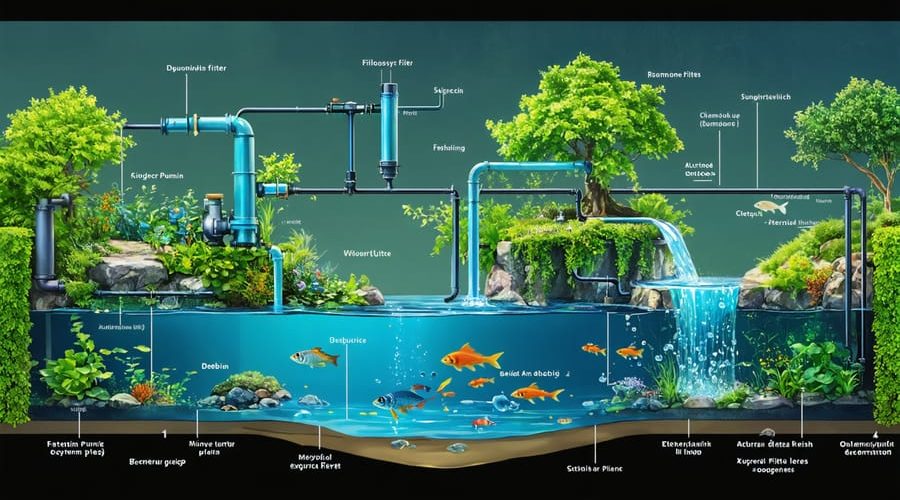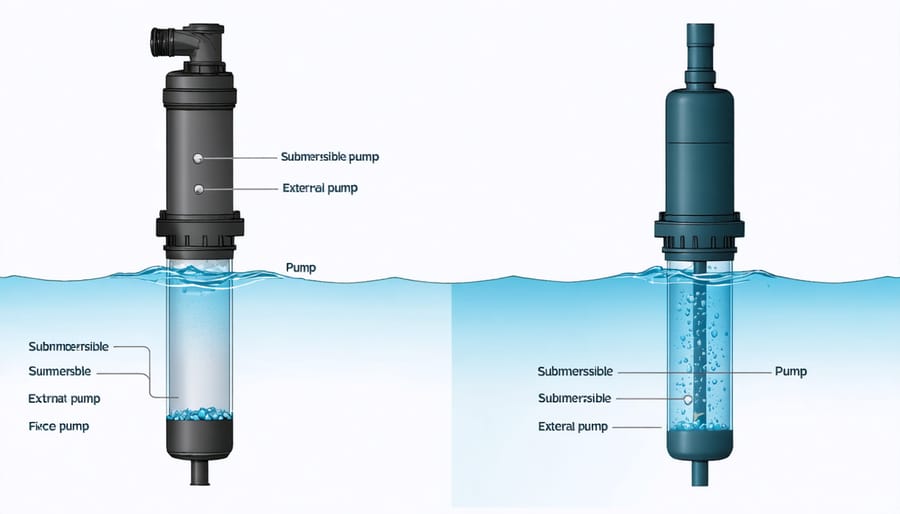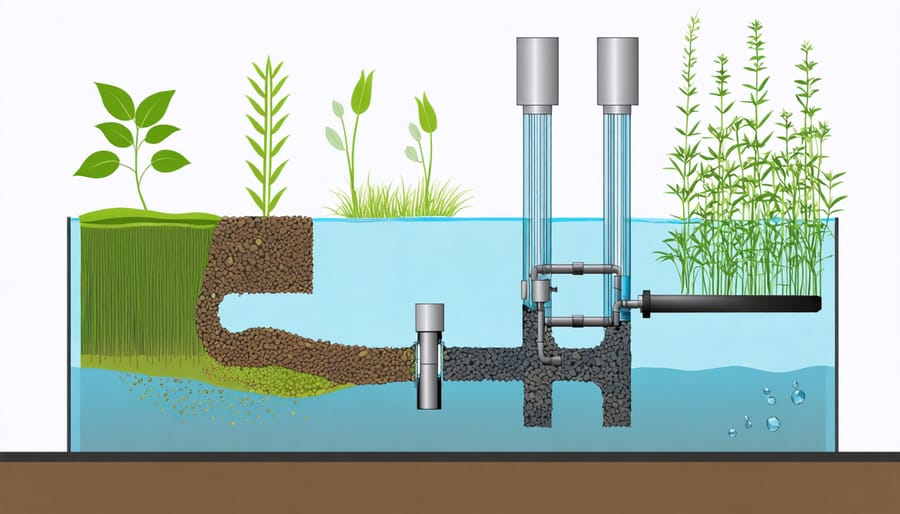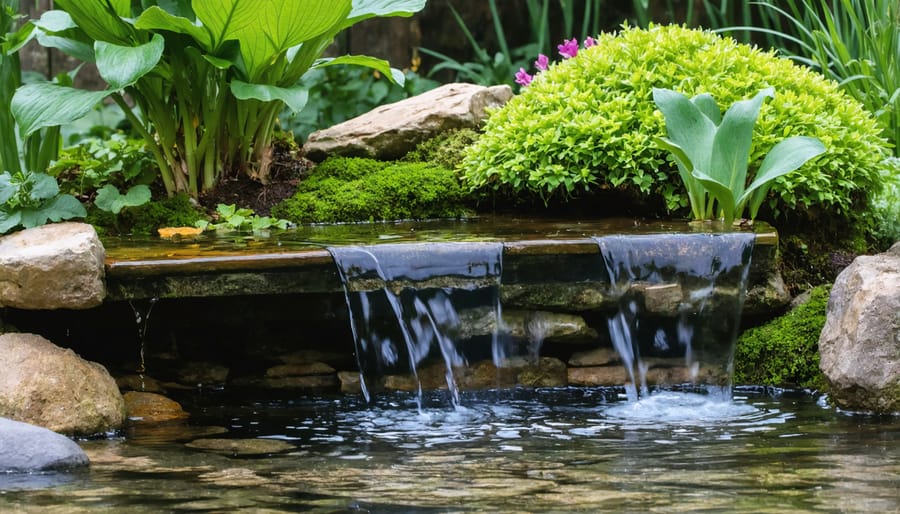
Perfect Pond Balance: How to Set Up a Fish-Friendly Pump and Filter System
A well-designed pond pump and filter system forms the beating heart of any thriving plant and fish ecosystem. Like a natural stream’s continuous flow, these systems work tirelessly to maintain crystal-clear water, optimal oxygen levels, and healthy living conditions for both aquatic life and decorative plants. Selecting the right combination of pumps and filters can seem daunting, but understanding the basics will help you create the perfect balance for your water feature. Whether you’re building a new pond or upgrading an existing setup, proper filtration is the key to maintaining a healthy aquatic environment that requires minimal maintenance and provides maximum enjoyment. From mechanical filters that capture debris to biological media that cultivate beneficial bacteria, each component plays a crucial role in sustaining your pond’s delicate ecosystem.
Understanding Your Pond’s Needs
Calculating Water Flow Requirements
Getting your pond’s water flow right is crucial for keeping your fish healthy and your water crystal clear. The general rule is to circulate your entire pond volume once every 1-2 hours. To calculate this, first measure your pond’s volume in gallons (length x width x average depth x 7.48 for rectangular ponds).
For example, if your pond holds 1,000 gallons, you’ll need a pump that moves 500-1,000 gallons per hour (GPH). However, if you keep koi, aim for the higher end of this range, as these fish produce more waste and need better filtration.
Remember to factor in “head height” – the vertical distance from your pump to where the water returns to the pond. For every foot of height, your pump loses some flow capacity. As a quick guide, add 10% more GPH for every foot of head height to your calculated flow rate.
Also consider any waterfalls or fountains you plan to add, as these features require additional flow to work properly. When in doubt, it’s better to choose a slightly larger pump than risk insufficient circulation.
Filter Capacity for Plant and Fish Load
Calculating your pond’s filter capacity needs isn’t as tricky as it might seem. Start by measuring your pond’s volume in gallons – multiply length x width x average depth (in feet) by 7.48. For every inch of fish, allow 1-2 gallons of water. So, if you have ten 6-inch koi, you’ll need at least 60-120 gallons dedicated to fish load.
For plants, consider their size and quantity. Each medium-sized aquatic plant typically needs about 2-3 gallons of water. A good rule of thumb is to ensure your filter can process the entire pond volume at least once every two hours for a well-stocked pond, or once every four hours for lightly stocked ponds.
Choose a filter rated at least 1.5 times your calculated needs to account for future growth and seasonal changes. If your pond holds 1,000 gallons with moderate fish and plant stock, look for a filter system rated for at least 1,500 gallons. Remember, it’s better to have slightly more filtering capacity than too little – your fish and plants will thank you for it!
Choosing the Right Pump System

Submersible vs External Pumps
When it comes to choosing a pump for your fish pond, you’ll typically decide between submersible and external pumps, each offering distinct advantages for your water garden. Let’s explore both options to help you make the best choice for your setup.
Submersible pumps sit directly in your pond water and are incredibly popular among beginners for good reason. They’re easy to install, generally cheaper, and operate quietly since they’re underwater. These pumps work great in smaller ponds and require minimal plumbing knowledge to set up. However, they can be less energy efficient and might need more frequent maintenance since they’re exposed to debris and pond muck.
External pumps, on the other hand, are installed outside your pond and typically last longer because they’re not constantly submerged. They’re more energy efficient and can handle larger water volumes, making them perfect for bigger ponds or those with lots of fish. The downside? They’re usually more expensive upfront and require more complex installation, including proper housing to protect them from the elements.
For plant environments, submersible pumps are often sufficient since they provide gentle water movement that won’t disturb delicate roots. However, if you’re keeping sensitive fish species or running advanced filtration systems, an external pump’s superior performance and reliability might be worth the extra investment. Consider your pond size, budget, and maintenance comfort level when making your choice.
Energy Efficiency and Performance
Choosing an energy-efficient pump and filter system isn’t just good for your wallet – it’s essential for maintaining a healthy pond ecosystem. Modern pond pumps come with impressive energy-saving features that can reduce your electricity costs while keeping your water crystal clear.
Look for pumps with adjustable flow rates, which allow you to match the pump’s output to your pond’s specific needs. Variable-speed pumps are particularly cost-effective, as they can automatically adjust their power usage based on the time of day or season. During winter months, when fish are less active, you can run the pump at a lower speed, significantly reducing energy consumption.
Solar-powered pumps are becoming increasingly popular among pond enthusiasts. While they have a higher upfront cost, they can dramatically reduce or eliminate ongoing electricity expenses. For best results, consider a hybrid system that combines solar power with traditional electric backup for cloudy days.
The size of your pump also matters. An oversized pump wastes energy and can stress fish, while an undersized one struggles to maintain proper filtration. As a rule of thumb, your pump should cycle your entire pond volume once every two hours for optimal efficiency.
Regular maintenance keeps your system running efficiently. Clean filters and clear pump intakes prevent your pump from working harder than necessary, which helps maintain energy efficiency and extends equipment life.
Filter Systems for Hybrid Ponds

Mechanical Filtration
Mechanical filtration is your pond’s first line of defense against physical debris like leaves, twigs, and other floating materials. Think of it as a series of increasingly fine sieves that catch particles of different sizes. The process typically starts with a skimmer or prefilter that captures larger debris before it can reach your pump. This initial screening prevents pump damage and ensures smoother operation of your entire system.
Most mechanical filters use foam or brush cartridges arranged in layers, with coarser materials catching bigger particles first, followed by finer media to trap smaller debris. Some systems also incorporate filter mats or pads that can be easily removed and cleaned. For the best results, position your mechanical filter before your biological filter in the water flow sequence.
Regular maintenance is crucial – aim to clean your mechanical filter every few weeks during peak season. You’ll know it’s time when water flow starts to decrease. A quick rinse with pond water (not tap water) will restore its effectiveness without disturbing beneficial bacteria that may have colonized the filter media.
Biological Filtration
Biological filtration is the heart of a healthy pond ecosystem, powered by beneficial bacteria systems that break down harmful waste products. These microscopic helpers transform fish waste and decaying organic matter into less harmful compounds through a two-stage process called nitrification.
Think of these bacteria as your pond’s natural cleaning crew. They colonize your filter media, converting toxic ammonia from fish waste into nitrites, and then into safer nitrates that plants can use as fertilizer. To help these beneficial bacteria thrive, your filter system should include materials with lots of surface area, such as bio-balls, ceramic rings, or lava rock.
For best results, keep your biological filter running 24/7, as these bacteria need constant water flow and oxygen to survive. When cleaning your filter, use pond water rather than tap water to preserve your bacterial colony. Remember, a well-established biological filter takes about 4-6 weeks to mature, so patience is key when starting up a new system.
Plant-Based Natural Filtration
Natural filtration using plants isn’t just beautiful – it’s a powerful ally in maintaining crystal-clear pond water. Aquatic plants for filtration work alongside your mechanical system to create a balanced ecosystem.
Water lilies, rushes, and cattails act as natural filters by absorbing excess nutrients and providing shelter for beneficial bacteria. These plants compete with algae for nutrients, naturally controlling their growth. Place marginal plants around your pond’s edge and floating plants on the surface to maximize filtration benefits.
For best results, aim to cover about 60% of your pond’s surface with plants. Water hyacinths and duckweed are particularly effective at removing nitrogen compounds, while iris and cattails excel at filtering out suspended particles. Remember to position plants where they won’t interfere with your pump’s intake.
Regular maintenance is simple – just trim dead foliage and divide overgrown plants seasonally. This prevents decomposing plant matter from adding nutrients back into the water. When combined with your mechanical filter system, these natural filters create a healthier environment for your fish while reducing the workload on your pump.
Think of plants as nature’s perfect filter – they work 24/7, look gorgeous, and help create that peaceful pond atmosphere we all love.
Installation and Maintenance Tips
Optimal Placement and Setup
The success of your pond’s filtration system largely depends on its placement and setup. For optimal performance, position your pump at the deepest part of the pond, which allows it to efficiently collect settling debris and maintain better water circulation. When installing, ensure the pump sits on a flat, stable surface – a concrete paver or sturdy plastic platform works well.
Your biological filter should be placed above the water level, allowing filtered water to create a natural waterfall effect as it returns to the pond. This not only adds aesthetic value but also helps oxygenate the water. Keep the filter within 6-10 feet of the pump to maintain strong water flow and reduce strain on the equipment.
For mechanical filters, consider accessibility for maintenance. Place them where you can easily reach them for regular cleaning without disturbing your pond’s ecosystem. If using a UV clarifier, install it between the pump and biological filter for maximum effectiveness.
Cable management is crucial – secure all electrical cords properly and ensure they’re protected from weather and wildlife. Use conduits or protective covers where necessary, and always maintain a “drip loop” in power cords to prevent water from running into electrical outlets.
Remember to test your system thoroughly before adding fish. Start with clear water and observe the flow patterns to ensure proper circulation throughout the entire pond. Adjust the placement if you notice any dead spots or areas with poor water movement.

Seasonal Maintenance Schedule
To keep your pond pump and filter system running smoothly throughout the year, follow these seasonal maintenance tips. In spring, kick off the season by thoroughly cleaning your filter media and checking all connections. As water temperatures rise, beneficial bacteria become more active, helping in maintaining crystal-clear pond water.
During summer, monitor your system weekly, removing any debris from the skimmer and pump basket. Clean mechanical filters monthly, but avoid washing biological media with tap water to preserve helpful bacteria. Keep an eye on water levels, as evaporation can affect pump performance.
Fall requires extra attention to falling leaves. Install a pond net to prevent debris from overwhelming your system. Clean your filters more frequently during this period, and remove any accumulated sludge from the bottom of your pond.
In winter, if you live in a mild climate, continue running your pump to prevent freezing. However, in severe winter areas, you may need to shut down the system and store the pump indoors. Before winter storage, clean all components thoroughly and check for wear and tear.
Remember to inspect O-rings and seals each season, replacing them if necessary. Regular maintenance keeps your system efficient and extends its lifespan, saving you money and ensuring healthy pond conditions year-round.
A well-designed pump and filter system is the heart of any healthy fish pond, keeping your aquatic paradise clean, clear, and thriving. Throughout this guide, we’ve explored the essential components, selection criteria, and maintenance requirements for creating an effective filtration setup that serves both your fish and plants.
Remember that successful pond filtration isn’t just about having the biggest or most expensive equipment – it’s about choosing the right combination of mechanical and biological filtration that matches your pond’s specific needs. Whether you’re working with a small decorative pond or a larger koi habitat, proper filtration will reward you with crystal-clear water and healthy, active fish.
Don’t be afraid to start small and upgrade as needed. Many pond owners find that beginning with a basic system and gradually improving it as they learn more about their pond’s requirements leads to the best results. Regular maintenance, while sometimes overlooked, is crucial for keeping your system running efficiently.
By implementing the guidelines we’ve discussed, you’ll be well on your way to maintaining a balanced ecosystem that brings joy for years to come. Take the time to plan your system carefully, perform regular maintenance checks, and make adjustments as needed. Your fish and plants – and everyone who enjoys your pond – will thank you for it.
Start your filtration journey today, and watch as your pond transforms into the serene water feature you’ve always dreamed of creating.
